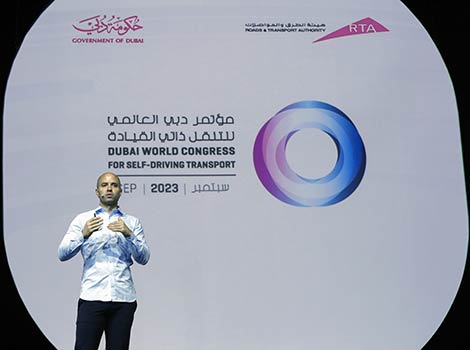Press Releases
27 Sep 2023
Future of Robotic Mobility for last mile delivery

Dubai World Congress for Self-Driving Transport which organized by Dubai Road and Transport Authority (RTA) under the slogan “Empowering the Future of Mobility” featured a session entitled “The Future of Robotic Mobility for Last Mile Delivery.”
Addressing the session Dr. Marko Bjelonic, Founder of Swiss Mile, reviewed the transformative impact of these robots in providing express delivery services in a cleaner, safer and lower-cost manner.
The design
He said that the transforming robot is a four-legged, semi-human vehicle that performs exceptional movement skills and drives at high speeds, overcoming difficult obstacles such as steps and stairs and enabling smooth movement in different environments. For example, agricultural, rocky areas and tunnels, and it can be dealt with in more than one language and with the touch feature.
He added that it was designed as an independent means of delivery, but its applications are scheduled to go beyond delivering packages. At the specified time, the robot can drive on four wheels, or transform to stand on two legs six feet high in the form of a rectum, and it uses a positioning system, sensors and cameras. To move independently, and able to switch between a two- or four-wheel configuration, becoming bipedal, the robot automatically changes its shape depending on the obstacles it encounters. Its movement is controlled by an artificial intelligence system to be more flexible compared to traditional robots. Besides its ability to deliver payloads ranging from online purchases to medical supplies and package deliveries. The robot also has a data mapping system.
Environmental and social advantages
Dr. Bjelonic spoke about the advantages of these robots in reducing carbon emissions, reducing traffic congestion, improving customer satisfaction, and charting a more sustainable future for delivery.
The future of robots
He mentioned the Future robots will be designed to rescue people and get them out of various disaster scenarios. It can be sent to unknown places to assess the environmental situation there and report it to rescue teams. This could be very useful in collapsed buildings, underground environments, and other disaster scenarios in the future.
At the conclusion of the session, he stressed that these technologies will contribute to the development of order delivery and it is expected that this sector will witness a major transformation, with the possibility of providing more efficient and effective services to customers.
